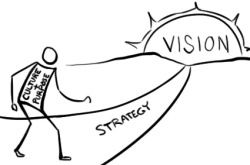Good Behaviour, Bad Behaviour
March 6, 2013 Leave a comment
 I have had some conversations this week around good vs bad behaviour in the workplace. Outside of commonly agreed bad behaviour or illegal/unethical behaviour, determining “bad behaviour” can be quite subjective – determined by formal and informal workplace culture. When a manager asks me to work with a staff member to make sure that they “behave well” in the workplace, I know that all of us are in for a challenge!
I have had some conversations this week around good vs bad behaviour in the workplace. Outside of commonly agreed bad behaviour or illegal/unethical behaviour, determining “bad behaviour” can be quite subjective – determined by formal and informal workplace culture. When a manager asks me to work with a staff member to make sure that they “behave well” in the workplace, I know that all of us are in for a challenge!
At the deepest level, “behaving well” is intrinsically motivated rather than extrinsically motivated. External motivation is based on what you do rather than who you are. For example, people highly motivated by recognition, strong or capable leadership and management, stability in their career, are externally motivated. People that are more internally motivated Read more of this post

 Culture can be defined as the set of beliefs and behaviours of an organisation’s workforce. It is created from the messages that are received about how people are expected to behave. Cultures bind people together through shared goals, beliefs, approaches, routines, needs and values. Peer pressure helps behavioural norms develop over time, and these are influenced by the type of work performed, organisational history, successes and failures, physical conditions, the workplace environment and the demands of external entities such as customers, stakeholders, economic conditions etc. But the strongest influence on cultural norms are the senior leaders and managers within an organisation. It is the messages and the behaviours of this group that is most influential in shaping the culture of an organisation.
Culture can be defined as the set of beliefs and behaviours of an organisation’s workforce. It is created from the messages that are received about how people are expected to behave. Cultures bind people together through shared goals, beliefs, approaches, routines, needs and values. Peer pressure helps behavioural norms develop over time, and these are influenced by the type of work performed, organisational history, successes and failures, physical conditions, the workplace environment and the demands of external entities such as customers, stakeholders, economic conditions etc. But the strongest influence on cultural norms are the senior leaders and managers within an organisation. It is the messages and the behaviours of this group that is most influential in shaping the culture of an organisation. 

 I came across these definitions of problem recently, and I loved them so much they brought a smile to my face. The definitions are succinct and accurate, and also are worthy of some contemplation.
I came across these definitions of problem recently, and I loved them so much they brought a smile to my face. The definitions are succinct and accurate, and also are worthy of some contemplation. It is interesting to be re-reading an article on Level 5 Leadership by Jim Collins, summarising the results of a five year project on companies that went from good to great and then sustained that greatness. He wrote a best selling book about this work — you have probably read it.
It is interesting to be re-reading an article on Level 5 Leadership by Jim Collins, summarising the results of a five year project on companies that went from good to great and then sustained that greatness. He wrote a best selling book about this work — you have probably read it.





